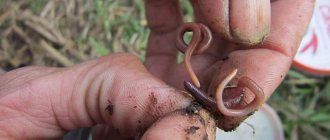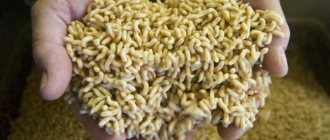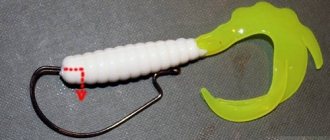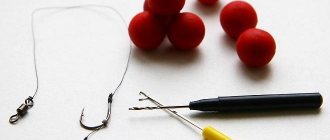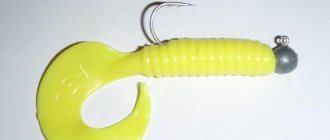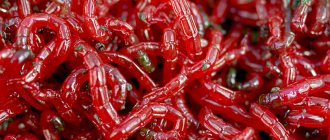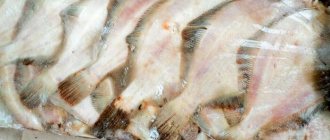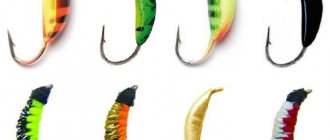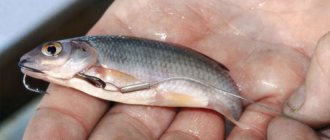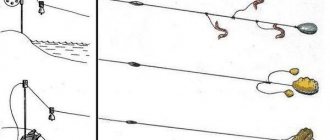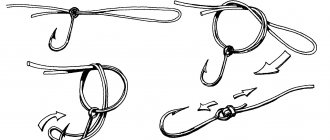The worm is an affordable and versatile bait that can be used to catch fish at any time of the year. The attachment can be combined with maggot, corn and pearl barley.
However, in order to attract the attention of the fish and not frighten it off prematurely with an untimely injection, it is important to correctly place the worm on the hook. Below you can find the most popular methods of baiting worms and typical mistakes that anglers make.
The worm can be skewered together with maggots to form a sandwich
What do anglers need to consider?
When going fishing, you need to purchase or dig up fresh invertebrates. It is important that the bait is mobile, because this is the kind of bait that can interest the fish.
Only hungry fish can bite on passive and saggy worms, so when attaching bait to a hook, it is important to follow the recommendations of experts.
To securely fix the worm, you should use a hook with a barb. The bait can be pierced several times or using clamps. When catching large fish, you need to use a large invertebrate.
In order for the bait to remain active for a long time, it is worth dipping the worm in hemp, sunflower or garlic extract. It is worth remembering that dung worms do not need additional aroma. If the bite is not satisfactory, you should try adding a small amount of chopped dill to the jar with invertebrates.
Note! The dimensions of the hook and bait should be identical.
If the worm is attached entirely, then the hook should have a long shank
How to choose bait for carp?
Of course, a good choice of bait will play a vital role when fishing for carp. Therefore, in addition to new popular methods, it is worth remembering undeservedly forgotten baits, such as worms. In most cases, a regular worm turns out to be the best bait for fish. Various types of worms are used to catch fish.
Read: Recipe for making dough for crucian carp - the basis of successful fishing
The most important thing in using worms is to examine the pond and understand whether carp dominates among other fish species. This bait is also suitable for other white fish.
It is best to use thick white worms, although red ones will also be useful - they can also be used as bait, especially if white ones cannot be found. Worms can be used in any way: as a base, placed directly on the hook, or as an addition to other types of complementary foods.
How can I plant it?
There are many ways to properly place a worm on a hook. Below you can find the most popular methods.
Stocking
This method is considered classic. The bait will work effectively, attracting the attention of both peaceful and predatory fish. You can bait not only whole worms, but also their parts.
Step by step process
- The sting is brought to the body of the worm. You can pierce it either from the end or in the middle.
- The bait is pulled onto the hook with a stocking to the point.
- The sting is removed.
If desired, you can bring the sting to the very edge.
The classic stocking is the second and third from the left, the first is a through puncture of the worm, the fourth is a way to put on one worm in a bun
Through puncture in several places
A whole worm needs to be pierced with a sting in several places (2-3). The tip is brought out at your own discretion. If there is a need to hide it, you should tighten the bait with a stocking after the second puncture.
Ring or figure eight
The upper part of the worm is pierced through with a sting. After that:
- prick the tail part onto the hook, while covering the sting;
- They make a through puncture in the middle part of the bait, due to which the appearance of the bait resembles a figure eight.
Using this method, you can plant a whole bunch of worms, which, upon reaching the water, will begin to wriggle with their front and back parts. Individuals must be the same size.
Zigzag
For the zigzag bait, anglers:
- pierce the worm in the front part;
- after 3 mm the sting is removed through;
- after 5-7 mm the body of the invertebrate is pierced.
The process must be repeated until a small tip of the worm's body remains, which will cover the tip.
The bait will look natural and attract the attention of both peaceful and predatory fish.
A method that is suitable for fishing in troubled waters
The worm is placed on the hook from the side of the body. You need to head towards the head of the invertebrate. Thus, the main part of the bait will be free and the worm will be able to actively wriggle, which will interest even well-fed fish and will be visible from afar.
How to properly attach a dung red worm to a hook - visual video:
Where can I get them?
They like places that are damp and shady. They are found under a layer of last year's foliage, in various ditches and wet holes, along temporarily dry streams. Attractive places for them are decaying trees and nettle roots.
To effectively extract worms from a pile of manure, ordinary agricultural forks are perfect. You can also collect worms in the garden while weeding the beds.
To provide yourself with worms and not worry about finding them, it is worth creating comfortable conditions for the animals. To do this, plant debris, rotted manure and compost are piled up. This mixture is periodically watered. The first worms can be collected within a couple of days.
Well, if you don’t want to search on your own, you can buy the required number of worms at a fishing store.
How to put a worm on a hook with a long and short shank
On hooks with a long shank, it is worth placing invertebrates in the form of a stocking or in a zigzag. At the same time, the mobility of the worms will remain, so you won’t have to wait long for a bite.
On hooks with a short shank you need to attach red dung worms, small rain crawlers, piercing their body in the middle. You can also use the piecemeal method.
Baiting worms in pieces is suitable for small hooks
How to dress an earthworm
Avid fishermen recommend using an earthworm for fishing large fish - pike perch, catfish, carp. First of all, you need to purchase medium and large hooks. The body of the invertebrate is pierced with a point in 3 places and strung on the forend. This method is suitable for lovers of bottom fishing.
Attaching an earthworm to a large hook
How to bait other types of worms
There are many ways to bait worms. If the invertebrate can be easily torn apart, it should be baited with stocking. It is very important to act slowly so as not to kill prematurely. The size of the worms should be identical to the size of the hooks.
Long worms are best divided into several parts. It is important that invertebrates can actively move. Strong worms must be hooked with the forend to the head and tail so that a ring is formed.
You can also bait worms with plant baits and maggots. Such sandwiches can whet the appetite not only of roach and crucian carp, but even of medium-sized pike.
You can put a worm on a hook using a stocking
The difference when choosing a worm for fishing, and which one is better to use
Today there are many types of bait, both plant and organic. Still, the earthworm was and remains the main specimen of any fisherman. Worms can be simple earthworms or garden worms, there are dung worms and also earthworms or forest worms. Which one to choose so that the fishing is a success or there is no difference.
In essence, they will peck at any of the above, but they still have their own priorities for certain species. When going fishing, it doesn’t matter who exactly preference should be given to dung worms. Thanks to its smell, it attracts fish twice as well, as well as the fact that it is much more mobile and stronger.
On a hook, it will wriggle and spin for a long time, while an ordinary earthworm will simply hang like a rope, and a live worm on a hook promises a larger catch than a dead one. It is not easy to attach such a worm; it constantly squirms, but it is worth threading it through the entire hook. You can achieve more effect if you attach one worm first and leave room for a second one; together they will look more lively for your trophy. When catching crucian carp, for example, dung worms are the most effective, as they are able to maintain fighting shape over a long bite.
Read: Liver is an excellent bait for fishing
You should not treat the worms with anise, as many people advise, thereby you will beat off its natural smell; in this case, everything should be only natural. This type of worm as bait is most effective during long-term fishing, when large prey such as carp or carp can be waited for hours, since the bait will look much fresher than an earthworm or forest worm. I will immediately place forest or earthworms in second place. They are red with a ring-shaped shell and also lively, in any case, better than earthen ones. They are easy to find under damp foliage or near lakes.
Bream and rudd do not disdain them at all, but still, if possible, a dung worm is needed. The liquid that comes out of its body when hooked, as I already said, has a specific smell and, once the fish has tried it, it will not lag behind. In addition, dung worms tolerate depth better than any other and are more durable than others. There is a type of worm called maggots, but it is only suitable for fast fishing with the current and also brings good results; be sure to try it, for example, on a bream or a track, you are guaranteed success. Good fishing and, as usual, good trophies!!!
How to attach a worm to a hair rig
To attach a worm using this method, you will need to prepare a leash (quick stop). Half of the large dendrobene worm is separated.
A thin needle is threaded into the quick stop. A stopper is inserted 2 cm into the inner part of the worm (from the side from which the second part of the invertebrate was torn off). The needle is removed. The worm is secured with a stopper. Dendrobena, once in the water, will actively wriggle and pull the leash behind it.
Hair attachment
How to put a worm on a hook when fishing for crucian carp, carp, bream, roach, silver carp
The way to dress the worm can be selected based on the type of fish you plan to catch:
- crucian carp, characterized by not being picky, unpretentious and a constant feeling of hunger. It is advisable to give preference to the stocking attachment. The tip of a medium-sized hook is brought out, because a small fish that is not able to swallow the bait can simply steal it.
- Roach . When fishing for roach, fishermen recommend stringing parts of earthworms onto a hook. The sting need not be brought out.
- Bream. In this case, you will need to give preference to the beam-shaped nozzle method. The sting must be closed. To attract the attention of bream, you should offer it large crawlers.
- Silver lob . To catch this type of fish, it is worth purchasing/digging up very large worms. You will need to string them using the figure eight method. The silver carp is cautious, so it is important to cover the sting.
- Depending on what body of water the carp , you can judge its food preferences. However, as a rule, carp are unlikely to refuse a worm that is hooked using the zigzag method.
How to properly place a worm on a hook for catching carp, bream, roach, crucian carp - visual video:
Methods for attaching a hook
Depending on what type of fish lives in a particular body of water, it is necessary to choose the right methods for attaching the worm and ways to secure it to the hook. When catching small fish, it is better to use small bait. Large earthworms are suitable for bream or crucian carp.
Before you plant the bait, you must follow some rules:
- The worm must be mobile. To do this, you need to try to damage it as little as possible.
- The size of the bait should match the size of the hook.
- It should not be allowed to bury itself in the bottom of the reservoir.
The most effective ways to attach a worm are to attach it with a stocking, a ring, pieces, or a bunch.
Stocking
This type of nozzle is the simplest. To rig this way, you need to pass the tip of the hook through the head of the worm, and then pull it so that the head is at the base of the hook where it is attached to the fishing line. It is necessary to leave a tail of the bait being strung on the tip of the hook. The size of the tail may vary. When using this type of attachment, you need to choose hooks made of thin wire with small notches at the base. They will help to better secure the bait and prevent the fish from quickly eating it.
With a ring
With this method, the worm is placed on the stocking, only the hanging tip of the worm is pierced again, thereby forming a ring. This type is used when catching large fish.
Pieces
This method of baiting involves dividing the worm into small pieces equal to 2 cm. Then each piece is placed on the hook separately. The number of such pieces on one hook can be anything. The larger the size of the intended fish, the more pieces should be on the hook.
This type is also used if the size of the worm is large for the intended fish.
The main disadvantage of this method is that when pierced, the worm becomes inactive and the fish loses interest in the bait, the number of bites is reduced.
Bun
This is how the bait is put on the hook if you are catching a large fish. The worm is pierced in the middle. Both ends remain free. In this case, it actively wriggles in the water, thereby attracting fish.
Common mistakes
Quite often, novice anglers make mistakes when stringing worms. The most common mistakes include:
- Using insufficient fresh worm . Such individuals will not actively move and will not attract the attention of fish.
- Baiting large worms on a small hook . In this case, the fish takes the bait and leaves.
- Using blunt hooks . It is difficult to pierce a worm with a dull point. The fisherman simply tears its body, which injures the invertebrate and reduces its viability.
- Pulling the entire body of an invertebrate onto a hook, placing it on a fishing line . In this case, there will be no movement of the worm, and, accordingly, no bites either.
How to put a worm on a hook - 10 ways to put worms on so that they hold tightly and do not spook the fish:
Advice! To attach long worms, it is recommended to use hooks with a long shank, which ensure maximum strength of the bait.
The worm is considered a universal bait that can attract the attention of not only bream, crucian carp and carp, but also perch and pike.
However, in order to catch such a trophy, it is important to familiarize yourself with the peculiarities of baiting worms and choose the most suitable method for a particular fishing location. If there are no bites, it is worth trying to change the type of bait and offer the fish instead of an earthworm, for example, a red dung worm, Dendroben, iron ore and subleaf.
Recommendations for choosing a rigging method when fishing for different types of fish
Each type of fish has its own specific feeding habits. Some species feed only at the bottom, others only at the surface, and others combine both. Fish also differ in the rate at which they consume the food they find. Some species immediately grab everything that moves, others repeatedly try, tug and only then swallow. Most often, the worm is used to catch fish from the bottom. Based on this specificity, fishermen have developed the most successful recommendations for catching various types of fish;
- For crucian carp. They use types of worm bait in which a long, moving tail or tails remain, except in cases where there are a lot of small crucian carp in the reservoir. For catching large and medium-sized crucian carp, a bunch of several small or medium-sized worms is suitable. For catching small crucian carp - pieces of a worm or its small specimens with the obligatory removal of the hook point outward. In some reservoirs, crucian carp prefers a worm that has already been chewed by previous bites. In this case, after baiting the hook, the tip of the worm is crushed;
- For bream. You can use “crucian carp” bait methods. Does not like bait that is too bulky. I really like bait made from several pieces of worm or a bunch of small worms. It can be useful, when baiting a worm with a “stocking,” to move it above the hook onto the fishing line. To catch large specimens, a medium-sized crawler with a tail hanging from a hook is used. In all methods, the sting of the hook is hidden inside the worm;
- For carp . Most often, a dung worm is used in the form of a garland of several worms. It is very good for catching carp to use a sandwich made of a worm, pierced at intervals and with a grain of corn. Baiting a hair rig with a worm pierced in two or three places has proven to work well. Used for catching carp and a bunch of small worms pierced with a hook in the middle. It happens that it bites well on earthworms collected near a pond;
- For catfish . The largest of the worms, the crawler, is used. 3-6 worms are placed on the hook. The catfish's mouth is huge and is capable of swallowing everything that is offered to it. To attach worms when catching catfish, in addition to a single hook, a double hook is used. It is useful to secure the worm on the hook with a stopper of animal or plant origin - maggot, live bait, leech, frog, locust, mole cricket, corn, pearl barley, clam.
